Sample Letter Of Memorandum Of Agreement
[Your Company Letterhead]
MEMORANDUM OF AGREEMENT
This Memorandum of Agreement ("MOA") is made and entered into on [Date] by and between [Your Company Name], a [Your Company Type] incorporated under the laws of [Your Country], with its principal place of business located at [Your Company Address] ("Company") and [Other Party’s Name], a [Other Party’s Company Type] incorporated under the laws of [Other Party’s Country], with its principal place of business located at [Other Party’s Address] ("Other Party").
WHEREAS, Company and Other Party are interested in cooperating with each other in order to achieve mutual benefits.
NOW, THEREFORE, the parties agree as follows:
Scope of Work: The parties agree to collaborate on [Describe the nature of the collaboration]. Each party shall perform the tasks and duties described in the attached Exhibit A.
Confidentiality: The parties shall maintain the confidentiality of any information received or exchanged pursuant to this MOA. The parties shall take reasonable steps to ensure that all confidential information is kept confidential.
Term: This MOA shall commence on [Date] and shall continue until [Date]. This MOA may be extended or renewed upon mutual agreement of the parties.
Termination: Either party may terminate this MOA upon written notice to the other party.
Intellectual Property: Each party shall retain ownership of its own intellectual property. The parties agree to negotiate in good faith any issues that may arise concerning the ownership, use, or licensing of any intellectual property created or used pursuant to this MOA.
Governing Law: This MOA shall be governed by and construed in accordance with the laws of [Your Country].
Entire Agreement: This MOA contains the entire agreement between the parties and supersedes all prior and contemporaneous agreements, understandings, negotiations, and discussions between the parties.
IN WITNESS WHEREOF, the parties have executed this MOA as of the date first above written.
[Your Company Name]
By: _____________________________
Name: ___________________________
Title: ____________________________
[Other Party’s Name]
By: _____________________________
Name: ___________________________
Title: ____________________________
Business Partnership MOA Letter
Subject: Memorandum of Agreement - Strategic Business Partnership
Dear [Partner Name],
This letter serves as a formal Memorandum of Agreement between [Your Company] and [Partner Company] regarding our proposed business partnership effective [Date].
The purpose of this agreement is to establish a mutually beneficial partnership wherein both parties will collaborate on [specific project/service]. [Your Company] will provide [your contributions] while [Partner Company] will contribute [their contributions].
Key terms of this agreement include:
- Partnership duration: [timeframe]
- Revenue sharing: [percentage breakdown]
- Responsibilities of each party as outlined in attached documentation
- Termination clause with 30-day written notice
Both parties acknowledge that this MOA represents our preliminary understanding and will be followed by a comprehensive legal agreement within [timeframe].
We look forward to a successful collaboration that benefits both organizations.
Sincerely,
[Your Name]
[Your Title]
[Company Name]
Event Collaboration MOA Email
Subject: MOA - Joint Event Collaboration Proposal
Hi [Collaborator Name],
Hope you're doing well! I'm reaching out to formalize our exciting collaboration for the upcoming [Event Name].
This email serves as our Memorandum of Agreement for the event scheduled on [Date] at [Venue]. Here's what we've agreed upon:
Your amazing team will handle:
- Event marketing and social media promotion
- Venue coordination and setup
- Guest registration and welcome activities
Our crew will take care of:
- Catering and refreshments
- Technical equipment and AV support
- Post-event cleanup and breakdown
Budget breakdown: We'll split costs 60/40 as discussed, with detailed expenses tracked and shared weekly.
This partnership is going to be fantastic! Let's make this event unforgettable for our attendees.
Looking forward to working together,
[Your Name]
Service Provider MOA Letter
Subject: Memorandum of Agreement - Professional Services
Dear [Service Provider],
This correspondence establishes a Memorandum of Agreement between [Your Organization] and [Service Provider] for professional services commencing [Start Date].
Scope of Services:
[Service Provider] agrees to provide [detailed description of services] in accordance with industry standards and best practices.
Terms and Conditions:
- Service period: [duration]
- Payment terms: [payment schedule and amounts]
- Deliverables: [specific outputs expected]
- Performance metrics: [measurable outcomes]
Quality assurance measures include regular progress reviews and milestone evaluations. Either party may terminate this agreement with [notice period] written notice.
This MOA shall remain in effect until superseded by a formal contract or terminated by mutual consent.
Please confirm your acceptance by returning a signed copy within five business days.
Best regards,
[Your Name]
[Position]
Research Collaboration MOA Email
Subject: MOA - Joint Research Project Collaboration
Dear Professor [Name],
I'm delighted to formalize our research collaboration through this Memorandum of Agreement.
Our joint research project on [Research Topic] will combine your expertise in [field] with our resources in [area]. This interdisciplinary approach promises groundbreaking results!
Project framework:
- Research timeline: [duration]
- Data sharing protocols: [specific arrangements]
- Publication rights: Co-authorship with alphabetical listing
- Funding responsibilities: [breakdown]
- Equipment and facility access: [details]
Intellectual property generated will be jointly owned, with commercialization decisions requiring mutual consent.
This collaboration represents an exciting opportunity to advance knowledge in our respective fields while fostering academic partnership.
Enthusiastically yours,
[Your Name]
[Institution]
Vendor Supply MOA Letter
Subject: Memorandum of Agreement - Supplier Partnership
Dear [Vendor Name],
This letter constitutes a Memorandum of Agreement establishing [Vendor Company] as a preferred supplier for [Your Company] effective [Date].
Supply arrangements include:
- Product categories: [list of items/services]
- Quality standards: [specifications and requirements]
- Delivery schedules: [timing and frequency]
- Pricing structure: [rates and payment terms]
- Minimum order quantities: [amounts]
Performance expectations encompass on-time delivery, quality compliance, and responsive customer service. Regular performance reviews will be conducted quarterly.
This MOA provides the foundation for our ongoing business relationship, subject to formal contract execution within 30 days.
We value your partnership and look forward to mutual success.
Cordially,
[Your Name]
[Procurement Manager]
Technology Partnership MOA Email
Subject: MOA - Technology Integration Partnership
Hi [Tech Partner],
Excited to move forward with our tech integration! This email serves as our Memorandum of Agreement for the upcoming project.
Integration details:
- Your platform will provide [specific technology/service]
- Our system will integrate via [method/API]
- Data exchange protocols: [security and format specifications]
- Testing phase: [timeline and milestones]
- Go-live date: [target launch]
Technical responsibilities:
You'll handle: API development, documentation, and technical support
We'll manage: Integration testing, user training, and deployment
This partnership will enhance both our offerings and create amazing value for users!
Ready to innovate together,
[Your Name]
[CTO/Technical Lead]
Non-Profit Collaboration MOA Letter
Subject: Memorandum of Agreement - Community Impact Partnership
Dear [Organization Leader],
It brings me great joy to formalize our partnership through this Memorandum of Agreement, united in our mission to serve the community.
Our collaborative initiative will address [social issue/community need] through combined efforts and shared resources.
Partnership commitments:
- [Your Organization]: [specific contributions and responsibilities]
- [Partner Organization]: [their contributions and roles]
- Joint activities: [shared programs and initiatives]
- Resource sharing: [equipment, volunteers, expertise]
Together, we can make a meaningful difference in the lives of those we serve. This MOA reflects our shared values and commitment to positive community impact.
Our partnership duration extends through [timeframe], with quarterly progress reviews to ensure we're meeting our community goals.
With heartfelt appreciation for your dedication,
[Your Name]
[Executive Director]
Real Estate Development MOA Letter
Subject: Memorandum of Agreement - Joint Real Estate Development
Dear [Development Partner],
This letter establishes a Memorandum of Agreement for our joint real estate development project at [Property Address].
Development terms:
- Property acquisition: [ownership structure]
- Development phases: [timeline and milestones]
- Financial contributions: [capital investment breakdown]
- Profit sharing: [percentage allocation]
- Management responsibilities: [roles and duties]
Regulatory compliance includes obtaining necessary permits, environmental assessments, and zoning approvals as required by local authorities.
Risk management provisions address market fluctuations, construction delays, and regulatory changes through shared responsibility and decision-making.
This MOA provides the framework for our development partnership, pending comprehensive legal documentation and due diligence completion.
Professionally yours,
[Your Name]
[Development Company]
What is a Memorandum of Agreement Letter and Why Do You Need One
A Memorandum of Agreement (MOA) letter is a preliminary document that outlines the basic terms and understanding between two or more parties before executing a formal contract. It serves as a bridge between initial discussions and final legal agreements.
Key purposes include:
- Establishing mutual understanding of partnership terms
- Creating accountability and commitment between parties
- Providing legal protection during negotiation phases
- Documenting agreed-upon responsibilities and expectations
- Facilitating smoother transition to formal contracts
- Reducing misunderstandings and disputes
Who Should Send MOA Letters
MOA letters are typically initiated by:
- Business owners seeking partnerships or collaborations
- Project managers coordinating multi-party initiatives
- Procurement officers establishing supplier relationships
- Academic researchers forming collaborative teams
- Non-profit directors creating community partnerships
- Legal representatives acting on behalf of clients
- Executives negotiating strategic alliances
- Event organizers coordinating with vendors and partners
When to Use Memorandum of Agreement Letters
MOA letters are appropriate in these scenarios:
- Beginning new business partnerships or joint ventures
- Establishing supplier or vendor relationships
- Coordinating collaborative projects or events
- Formalizing research or academic collaborations
- Creating non-profit community partnerships
- Negotiating real estate development agreements
- Setting up technology integration partnerships
- Initiating service provider arrangements
- Planning merger or acquisition discussions
- Establishing licensing or franchise relationships
Requirements and Prerequisites Before Writing MOA Letters
Essential preparations include:
- Clear understanding of your organization's goals and limitations
- Legal consultation to ensure compliance with applicable laws
- Financial analysis of proposed partnership costs and benefits
- Internal approval from board members or stakeholders
- Market research on potential partners' reputation and capabilities
- Risk assessment of partnership implications
- Documentation of existing intellectual property or assets
- Identification of key personnel who will manage the partnership
- Budget allocation for partnership activities and legal fees
How to Write and Send Effective MOA Letters
The writing process involves:
- Conducting preliminary discussions to align expectations
- Researching legal requirements specific to your industry
- Drafting clear, concise terms that avoid ambiguous language
- Including specific timelines, responsibilities, and deliverables
- Reviewing with legal counsel before sending
- Using formal business letter format for printed documents
- Sending via certified mail for important agreements
- Following up with email confirmation of receipt
- Scheduling meetings to discuss and refine terms
- Maintaining professional tone throughout negotiations
Formatting Guidelines for MOA Letters
Optimal formatting includes:
- Professional letterhead with complete contact information
- Clear subject line indicating "Memorandum of Agreement"
- Formal salutation addressing specific individuals
- Structured body paragraphs covering key terms
- Bullet points for complex terms or multiple responsibilities
- Professional closing with signature lines for all parties
- Page length typically 1-2 pages for initial MOAs
- Font size 11-12 points in professional typefaces
- 1-inch margins with single or 1.15 line spacing
- Date and reference numbers for tracking purposes
Elements and Structure Required in MOA Letters
Essential components include:
- Opening: Clear identification of all parties involved
- Purpose statement: Specific reason for the agreement
- Scope of work: Detailed description of activities or services
- Responsibilities: Clear division of duties between parties
- Timeline: Specific dates for milestones and completion
- Financial terms: Payment schedules, cost sharing, or revenue splits
- Performance metrics: Measurable outcomes or quality standards
- Termination clause: Conditions for ending the agreement
- Legal disclaimers: Statements about binding nature and governing law
- Signature section: Spaces for all parties to sign and date
Follow-up Actions After Sending MOA Letters
Post-sending activities include:
- Confirming receipt within 2-3 business days
- Scheduling follow-up meetings to discuss terms
- Negotiating modifications or clarifications as needed
- Setting deadlines for partner responses
- Preparing formal contracts based on MOA terms
- Conducting due diligence on partner organizations
- Establishing regular communication schedules
- Creating project management systems for tracking progress
- Documenting all correspondence for legal records
- Planning implementation phases upon agreement finalization
Common Mistakes to Avoid When Writing MOA Letters
Frequent pitfalls include:
- Using vague language that allows multiple interpretations
- Omitting specific timelines or deadlines
- Failing to include termination or modification clauses
- Not specifying financial responsibilities clearly
- Overlooking intellectual property considerations
- Excluding dispute resolution mechanisms
- Sending without proper legal review
- Using overly complex legal jargon that confuses rather than clarifies
- Not addressing confidentiality requirements
- Failing to specify governing law or jurisdiction
- Omitting performance measurement criteria
Advantages and Disadvantages of MOA Letters
Advantages:
- Establishes commitment without full legal complexity
- Faster negotiation compared to formal contracts
- Provides framework for detailed contract development
- Creates accountability between parties
- Offers some legal protection during negotiations
- Facilitates clear communication of expectations
Disadvantages:
- Less legally binding than formal contracts
- May create false sense of security
- Can delay final contract execution
- May not cover all necessary legal protections
- Requires follow-up with formal agreements
- Potential for disputes over interpretation
Tips and Best Practices for MOA Letters
Professional strategies:
- Keep language clear and business-focused
- Include specific metrics and measurable outcomes
- Set realistic timelines with buffer periods
- Address confidentiality and non-disclosure requirements
- Specify communication protocols and key contacts
- Include provisions for dispute resolution
- Use templates but customize for each situation
- Maintain consistent formatting and professional presentation
- Archive all versions and correspondence for legal records
- Consider cultural and regional business practices when working internationally

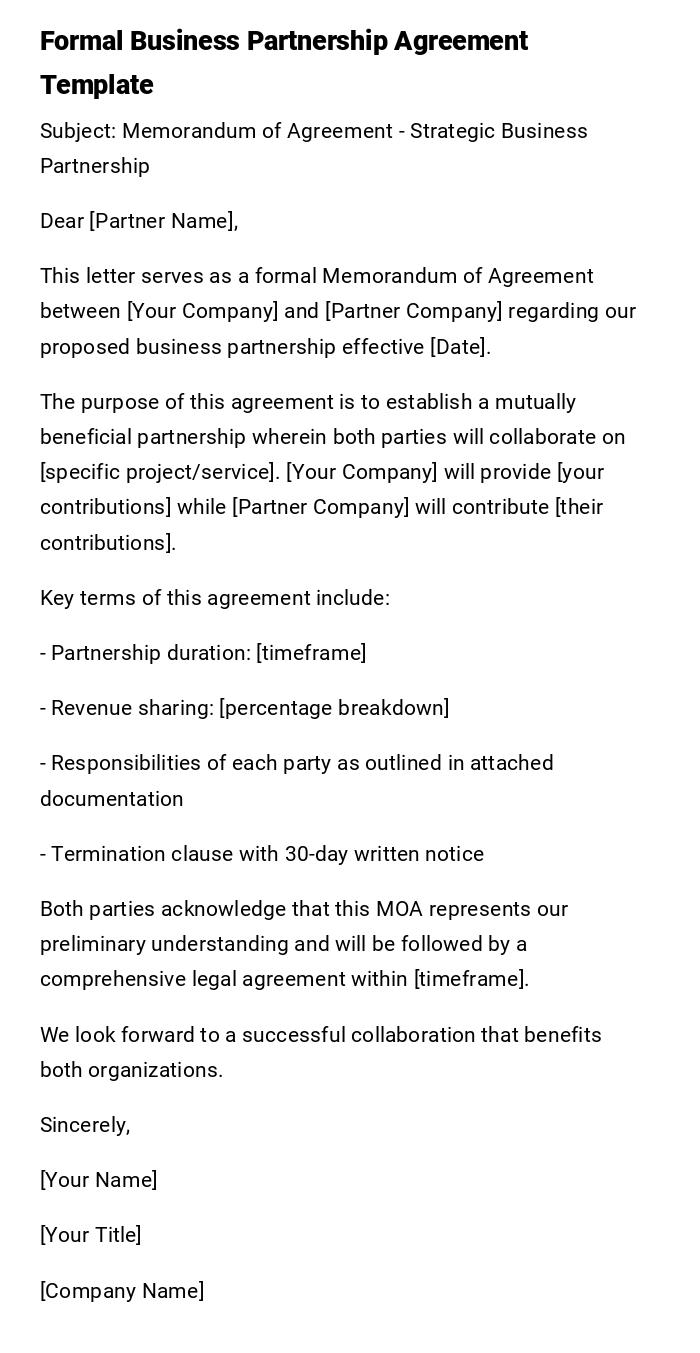
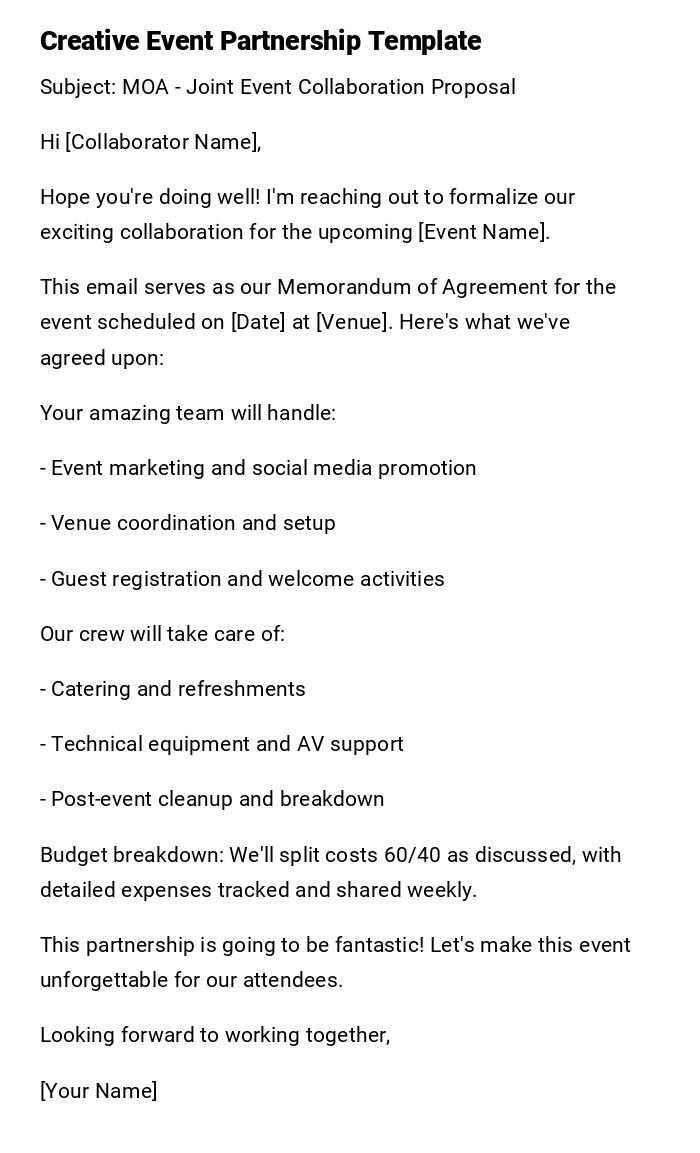
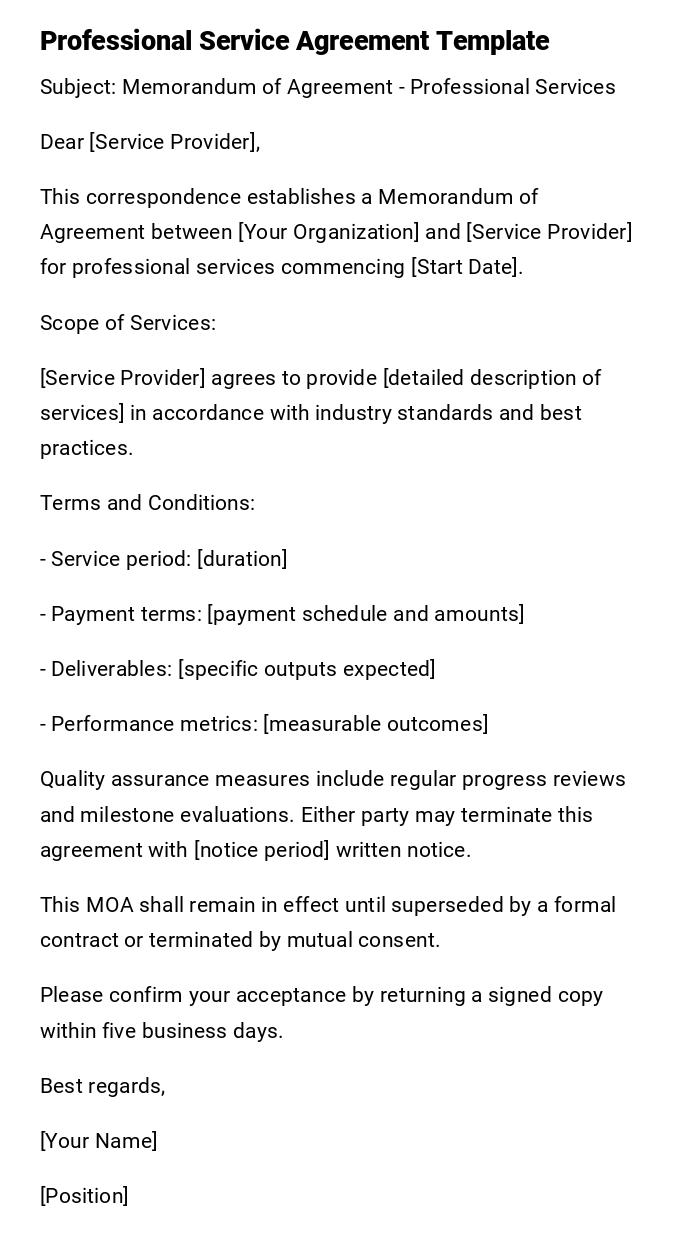

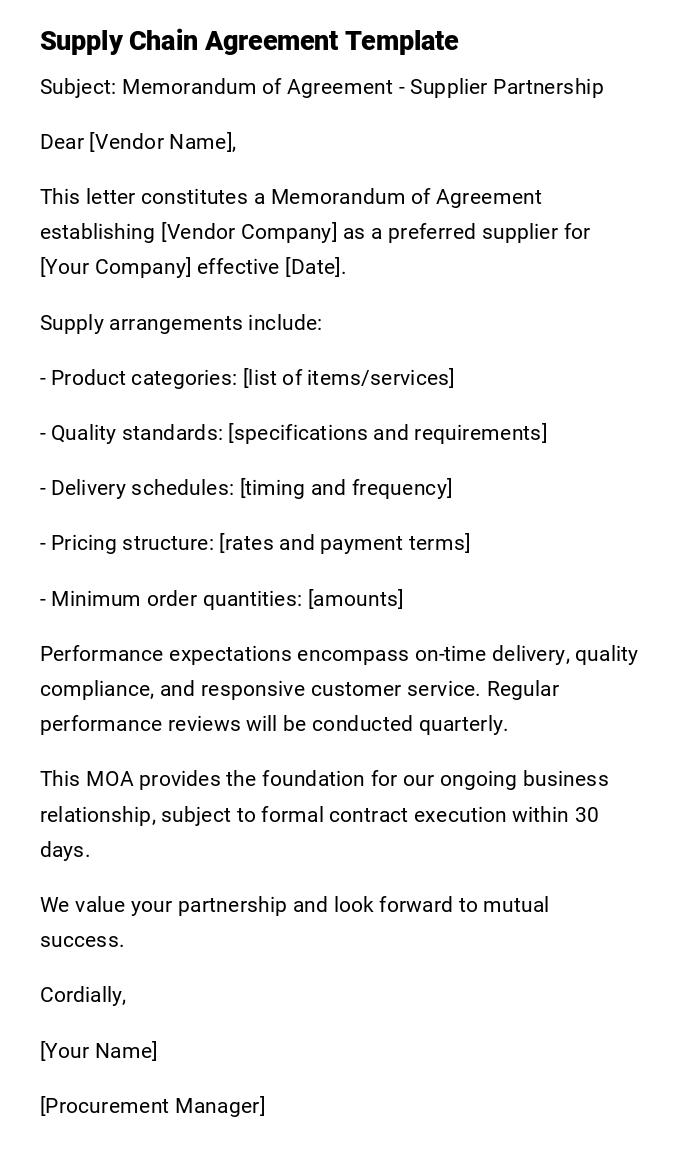


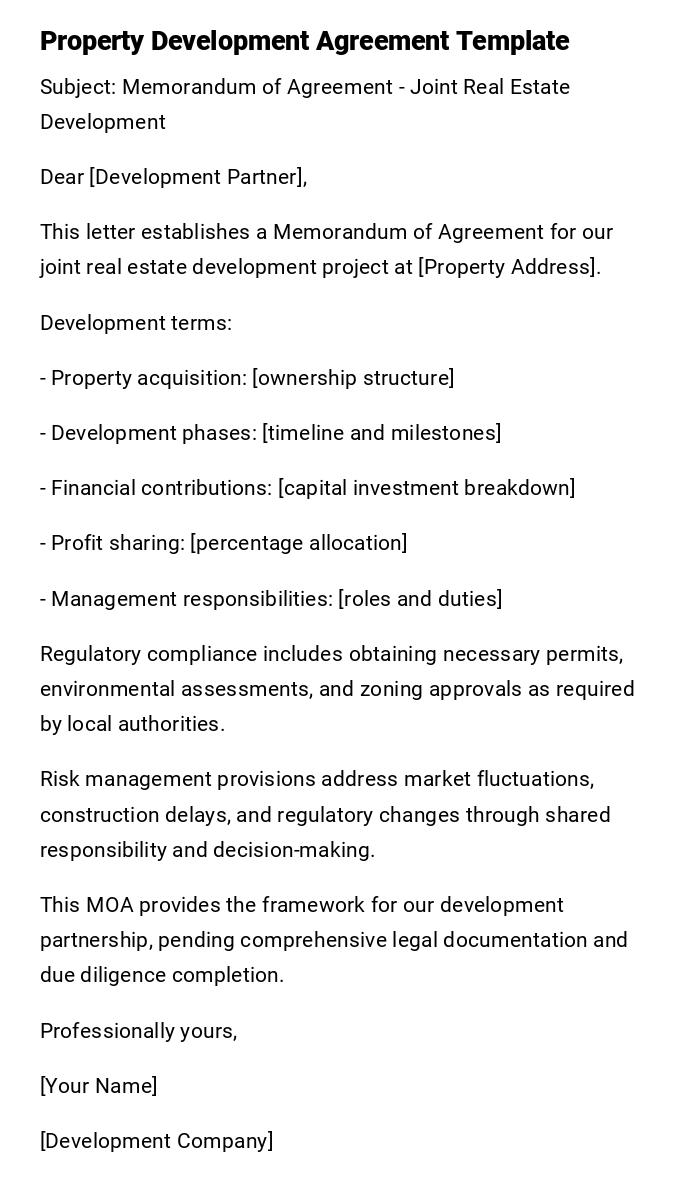

 Download Word Doc
Download Word Doc
 Download PDF
Download PDF